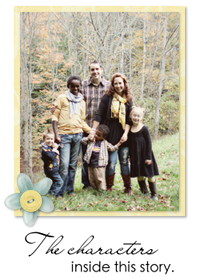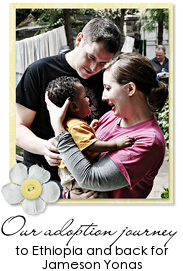Attachment and bonding are often used interchangeably; however, they are two very different processes. Bonding is that phase of falling in love with your child and your child with you. Jim and I were very blessed to feel this instantaneous love for Jamesy upon meeting him. (It is natural and normal for other adopting families to not feel this immediate love, and it in no way indicates that there are problems ahead. Sometimes love has to grow. Adoption, while beautiful, is unnatural, and by that I simply mean that adoption is not how God originally intended for families to grow. Adoption did not exist until after sin entered the world.) While we feel love for Jamesy, he does not feel that same love toward us so we have yet to bond. The bonding process is typically relatively short with a younger child. It usually begins to occur within a few weeks. Bonding is about sharing love, relationship, and commitment. We have done very little so far (in the grand scheme of his life) to foster bonding with him. Even after our days with Jamesy in Ethiopia, we are still essentially strangers to him. Much of bonding involves physical touch. This is why it sometimes (not all of the time - not every case) appears easier and faster for adopting families to bond with infants rather than older children. Infants require a lot of physical touch, and it is instinctual and natural for most parents to touch and nurture an infant - even for those adults who are not inclined to a lot of physical touching in how they parent. I believe that bonding, especially after a child is adopted, must be initiated by the parents. A child that comes from a hard place will not usually, naturally interact with his or her new family through physical touch. It is a process that must be taught and prayerfully will eventually be mirrored and reciprocated in our son.
Attachment is bigger and more complicated and usually takes much longer than bonding (think months not weeks and sometimes even years). Simply stated attachment is a process of trust. I believe that the research for attachment is extensive, on-going and changing, and because every child is so different it is very important to continually and constantly be researching, learning, and growing as parents while giving our children over to God. Some research indicates that the attachment process begins in the womb as the baby receives nourishment from the mother. I am not educated enough to say whether or not this is factual. However, I have heard some very convincing theories that babies in utero who experience trauma or stress will have a brain that develops differently from a baby who did not experience such things. From these studies it truly does seem to indicate that the attachment process is not only very real, but happens very early in a child's life. Regardless of that, I do believe that enough data has been collected to prove that during a child's first 18 months of life, he or she has learned whether or not their caregivers can be trusted to meet their needs. When a child's needs are met continually in the first 18 months of life, the attachment process begins in a healthy normal manner. However, when needs are repeatedly unmet- for example a baby cries out for food and no food is given, the attachment process is disrupted. Although, it is unlikely that a child would remember this occurrence, the affects of this could have lifelong implications if tools to heal this wounded child's heart are not implemented. Children who are in orphanages may discover that sometimes their needs are met and sometimes they are not, so they learn to trust no one. Sadly many of these children have had to find ways to gratify and sooth themselves - even at very young ages.
As Jamesy's parents we feel that it is absolutely vital to commit to fostering both bonding and attachment between ourselves and Jamesy and among our family as a whole. We understand through various research that the first few weeks and months that Jamesy is home with us are absolutely critical to the future healing that we desire to take place in his heart. Jim and I are ready to invest our time and our energy into doing everything we can to transition Jamesy into our home - into our family. Now that I have set the groundwork for why we feel this is so necessary I will share in my next post how we plan to do it and exactly what our attachment plan looks like. Hopefully in sharing all of this, it will make our plan a little more understandable and less crazy sounding! I am leaving comments open for the time being. If you have any questions, please feel free to ask, and I will respond in the comment section in order to continue the dialogue.
Attachment is bigger and more complicated and usually takes much longer than bonding (think months not weeks and sometimes even years). Simply stated attachment is a process of trust. I believe that the research for attachment is extensive, on-going and changing, and because every child is so different it is very important to continually and constantly be researching, learning, and growing as parents while giving our children over to God. Some research indicates that the attachment process begins in the womb as the baby receives nourishment from the mother. I am not educated enough to say whether or not this is factual. However, I have heard some very convincing theories that babies in utero who experience trauma or stress will have a brain that develops differently from a baby who did not experience such things. From these studies it truly does seem to indicate that the attachment process is not only very real, but happens very early in a child's life. Regardless of that, I do believe that enough data has been collected to prove that during a child's first 18 months of life, he or she has learned whether or not their caregivers can be trusted to meet their needs. When a child's needs are met continually in the first 18 months of life, the attachment process begins in a healthy normal manner. However, when needs are repeatedly unmet- for example a baby cries out for food and no food is given, the attachment process is disrupted. Although, it is unlikely that a child would remember this occurrence, the affects of this could have lifelong implications if tools to heal this wounded child's heart are not implemented. Children who are in orphanages may discover that sometimes their needs are met and sometimes they are not, so they learn to trust no one. Sadly many of these children have had to find ways to gratify and sooth themselves - even at very young ages.
As Jamesy's parents we feel that it is absolutely vital to commit to fostering both bonding and attachment between ourselves and Jamesy and among our family as a whole. We understand through various research that the first few weeks and months that Jamesy is home with us are absolutely critical to the future healing that we desire to take place in his heart. Jim and I are ready to invest our time and our energy into doing everything we can to transition Jamesy into our home - into our family. Now that I have set the groundwork for why we feel this is so necessary I will share in my next post how we plan to do it and exactly what our attachment plan looks like. Hopefully in sharing all of this, it will make our plan a little more understandable and less crazy sounding! I am leaving comments open for the time being. If you have any questions, please feel free to ask, and I will respond in the comment section in order to continue the dialogue.










 Addis Ababa Time
Addis Ababa Time
6 comments:
Thank you for sharing your gift of expression through writing. I do not have this gift so I enjoy reading when it is from the heart.
Thanks for sharing :-) I will be looking forward to your next post. I have read some opinions on this on different forums but there is so much varying opinions that I have found it hard to really educate myself on it.
THANK YOU for sharing these posts...I especially appreciated the analogy you shared in your last post. You explain everything so clearly and simply. I, too, am eager to read your "plan" = )
My heart is just turning and turning and turning in excitment for you. However, I see the intensity behind these posts and realize that your journey truly is just beginning. I know that you and Jim will do a great job of nurturing this sweet guy into your lives. You know we are praying and will be through it all. You're doing great, Tiff.
"Sadly many of these children have had to find ways to gratify and sooth themselves - even at very young ages"
i understand you are talking about extreme circumstances in this particular instance, but does this mean you feel as though it isn't appropriate to encourage young children and babies to learn to self-sooth?
Anonymous~
I am referring to extreme cases - specifically children who have lived in an institution. I am talking about extreme self-soothing behaviors such as body rocking, head rocking-banging, hair twisting or pulling, self mutilation etc. Personally, I do not think these behaviors should be encouraged, but I understand in an understaffed institution where children are getting very little stimulation these behaviors are often a means of survival for them, and I was trying to communicate that it was a sad fact (that they needed to do this).
Personally, with my children in my home, yes, I have encouraged self-soothing techniques such as thumb sucking in my middle son and both children sleep with blankies. Those kind of things are for each family to determine on their own.
Post a Comment